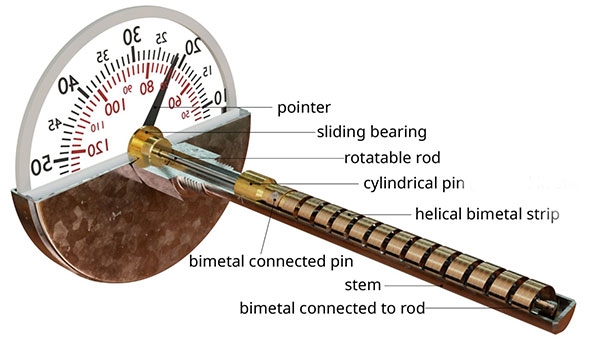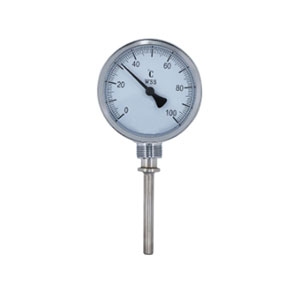A bimetallic thermometer is a common sensor used for measuring temperature. It is composed of two different metals stacked together, and their slight deformation due to differential expansion rates caused by temperature changes is used to measure temperature. In this article, sisco will introduce the working principle, structure, features and applications of bimetallic thermometers.
Structure of Bimetallic Thermometers
A typical bimetallic thermometer consists of four parts: a vacuum tube, mechanical connection, bimetallic strip, and a pointer.
- Vacuum Tube: Used to prevent external atmospheric pressure interference, maintaining a vacuum inside the thermometer.
- Mechanical Connection: Connects the bimetallic strip to the pointer, transmitting the bending degree of the bimetallic strip.
- Bimetallic Strip: Composed of two different metal strips bonded together. When subjected to temperature changes, the bimetallic strip undergoes different thermal expansions, causing the entire strip to bend.
- Pointer: Measurement device that outputs the indicated angle transmitted by the bimetallic strip.

Working Principle of Bimetallic Thermometers
Bimetallic thermometers operate based on the thermal physical effect of two metals with different expansion rates. When two metals are overlaid and fixed, temperature changes result in different thermal expansions, causing the bimetallic strip to bend. Thus, the degree of bending of the bimetallic strip is directly proportional to the temperature.
Assuming an increase in temperature causes the entire strip to bend upward, the metal strip with a smaller expansion coefficient undergoes tension, while the metal strip with a larger expansion coefficient undergoes compression.
Note: The function of the push rod is crucial and should not be allowed to move freely up and down.
Characteristics of Bimetallic Thermometers
- Bimetal Structure: Bimetallic thermometers are composed of two different
 metals stacked together, typically using metal strips with different linear expansion coefficients, such as copper and iron. When subjected to temperature changes, the differential expansion of the two metals causes the bimetallic strip to bend, allowing temperature changes to be deduced by observing or measuring the deformation.
metals stacked together, typically using metal strips with different linear expansion coefficients, such as copper and iron. When subjected to temperature changes, the differential expansion of the two metals causes the bimetallic strip to bend, allowing temperature changes to be deduced by observing or measuring the deformation. - Suitable for Temperature Difference Measurement: Bimetallic thermometers are commonly used for measuring relatively small temperature differences rather than absolute temperatures. They are highly sensitive to detecting temperature changes in a system, making them effective in applications where temperature differences need to be monitored.
- Simple and Economical: Bimetallic thermometers are typically manufactured in a simple and compact form, resulting in lower manufacturing costs. This makes them an economical and practical solution for temperature measurement.
- High Reliability: Due to the relatively simple structure of bimetallic thermometers, they generally exhibit high reliability. They provide stable and reliable performance, especially in industrial environments, for various temperature measurement applications.
- Mechanical Principle: The working principle of bimetallic thermometers is based on the thermal expansion characteristics of metals. When the temperature increases, the metal expands, and when the temperature decreases, the metal contracts. This physical principle allows bimetallic thermometers to provide accurate measurements within a certain temperature range.
Applications of Bimetallic Thermometers
Bimetallic thermometers find widespread application in various settings, such as thermal systems in industrial equipment requiring temperature measurement, furnaces, temperature measurement in laboratory scientific research, and monitoring patient body temperature by healthcare professionals.
Due to the high accuracy achievable with bimetallic thermometers, they are particularly popular in applications in industrial and medical fields. In furnaces, bimetallic thermometers are commonly used for real-time temperature detection and control.
The most common industry developing bimetallic thermometers is the field of automation control. In such applications, bimetallic thermometers can convert signals into digital or analog outputs through sensor chipsets, enabling more precise automated control.
In summary, the bimetallic thermometer is a widely used sensor for measuring temperature. Its operating principle is based on the thermal physical effect of two metals with different expansion rates. By stacking and connecting two metal strips, their slight deformation due to the differential expansion coefficients allows measurement of temperature. Applications can be found in industrial equipment and medical devices, such as real-time furnace temperature detection and automated control through digital outputs.

